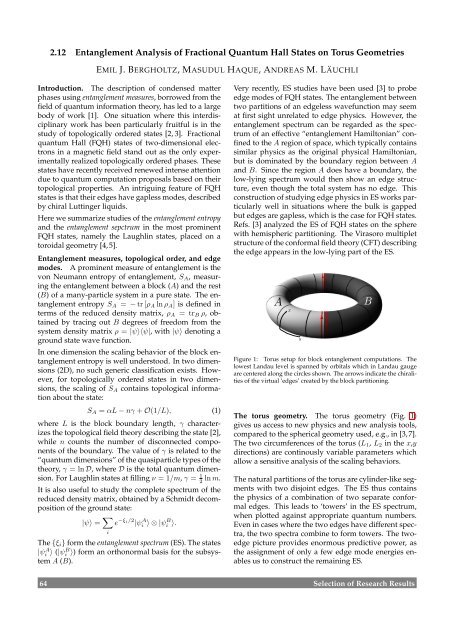Contents - Max-Planck-Institut für Physik komplexer Systeme
Contents - Max-Planck-Institut für Physik komplexer Systeme
Contents - Max-Planck-Institut für Physik komplexer Systeme
You also want an ePaper? Increase the reach of your titles
YUMPU automatically turns print PDFs into web optimized ePapers that Google loves.
2.12 Entanglement Analysis of Fractional Quantum Hall States on Torus Geometries<br />
EMIL J. BERGHOLTZ, MASUDUL HAQUE, ANDREAS M. LÄUCHLI<br />
Introduction. The description of condensed matter<br />
phases using entanglement measures, borrowed from the<br />
field of quantum information theory, has led to a large<br />
body of work [1]. One situation where this interdisciplinary<br />
work has been particularly fruitful is in the<br />
study of topologically ordered states [2, 3]. Fractional<br />
quantum Hall (FQH) states of two-dimensional electrons<br />
in a magnetic field stand out as the only experimentally<br />
realized topologically ordered phases. These<br />
states have recently received renewed intense attention<br />
due to quantum computation proposals based on their<br />
topological properties. An intriguing feature of FQH<br />
states is that their edges have gapless modes, described<br />
by chiral Luttinger liquids.<br />
Here we summarize studies of the entanglement entropy<br />
and the entanglement sepctrum in the most prominent<br />
FQH states, namely the Laughlin states, placed on a<br />
toroidal geometry [4, 5].<br />
Entanglement measures, topological order, and edge<br />
modes. A prominent measure of entanglement is the<br />
von Neumann entropy of entanglement, SA, measuring<br />
the entanglement between a block (A) and the rest<br />
(B) of a many-particle system in a pure state. The entanglement<br />
entropy SA = −tr [ρA lnρA] is defined in<br />
terms of the reduced density matrix, ρA = trB ρ, obtained<br />
by tracing out B degrees of freedom from the<br />
system density matrix ρ = |ψ〉〈ψ|, with |ψ〉 denoting a<br />
ground state wave function.<br />
In one dimension the scaling behavior of the block entanglement<br />
entropy is well understood. In two dimensions<br />
(2D), no such generic classification exists. However,<br />
for topologically ordered states in two dimensions,<br />
the scaling of SA contains topological information<br />
about the state:<br />
SA = αL − nγ + O(1/L), (1)<br />
where L is the block boundary length, γ characterizes<br />
the topological field theory describing the state [2],<br />
while n counts the number of disconnected components<br />
of the boundary. The value of γ is related to the<br />
“quantum dimensions” of the quasiparticle types of the<br />
theory, γ = ln D, where D is the total quantum dimension.<br />
For Laughlin states at filling ν = 1/m, γ = 1<br />
2 lnm.<br />
It is also useful to study the complete spectrum of the<br />
reduced density matrix, obtained by a Schmidt decomposition<br />
of the ground state:<br />
|ψ〉 = <br />
i<br />
e −ξi/2 |ψ A i 〉 ⊗ |ψ B i 〉.<br />
The {ξi} form the entanglement spectrum (ES). The states<br />
|ψA i 〉 (|ψB i 〉) form an orthonormal basis for the subsystem<br />
A (B).<br />
Very recently, ES studies have been used [3] to probe<br />
edge modes of FQH states. The entanglement between<br />
two partitions of an edgeless wavefunction may seem<br />
at first sight unrelated to edge physics. However, the<br />
entanglement spectrum can be regarded as the spectrum<br />
of an effective “entanglement Hamiltonian” confined<br />
to the A region of space, which typically contains<br />
similar physics as the original physical Hamiltonian,<br />
but is dominated by the boundary region between A<br />
and B. Since the region A does have a boundary, the<br />
low-lying spectrum would then show an edge structure,<br />
even though the total system has no edge. This<br />
construction of studying edge physics in ES works particularly<br />
well in situations where the bulk is gapped<br />
but edges are gapless, which is the case for FQH states.<br />
Refs. [3] analyzed the ES of FQH states on the sphere<br />
with hemispheric partitioning. The Virasoro multiplet<br />
structure of the conformal field theory (CFT) describing<br />
the edge appears in the low-lying part of the ES.<br />
A B<br />
x<br />
y<br />
Figure 1: Torus setup for block entanglement computations. The<br />
lowest Landau level is spanned by orbitals which in Landau gauge<br />
are centered along the circles shown. The arrows indicate the chiralities<br />
of the virtual ‘edges’ created by the block partitioning.<br />
The torus geometry. The torus geometry (Fig. 1)<br />
gives us access to new physics and new analysis tools,<br />
compared to the spherical geometry used, e.g., in [3,7].<br />
The two circumferences of the torus (L1, L2 in the x,y<br />
directions) are continously variable parameters which<br />
allow a sensitive analysis of the scaling behaviors.<br />
The natural partitions of the torus are cylinder-like segments<br />
with two disjoint edges. The ES thus contains<br />
the physics of a combination of two separate conformal<br />
edges. This leads to ‘towers’ in the ES spectrum,<br />
when plotted against appropriate quantum numbers.<br />
Even in cases where the two edges have different spectra,<br />
the two spectra combine to form towers. The twoedge<br />
picture provides enormous predictive power, as<br />
the assignment of only a few edge mode energies enables<br />
us to construct the remaining ES.<br />
64 Selection of Research Results
















